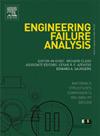Interrelationship among wear, debris, and friction-induced stick-slip vibration at high-speed train brake interfaces in humid environments
IF 5.7
2区 工程技术
Q1 ENGINEERING, MECHANICAL
引用次数: 0
Abstract
During the friction braking process of high-speed trains, the strong friction between the brake discs and brake pads can cause significant wear on the pads, resulting in a large amount of wear debris that participates in the friction at the braking interface. Particularly in humid environments, the strong friction can induce significant friction-induced stick–slip vibrations (FISSV). Additionally, the humid environment promotes oxidation reactions, leading to the formation of harder wear debris that induces abrasive wear. Both abrasive wear and the impacts of FISSV can cause damage to the braking interface, posing significant challenges to the operational safety of the pads. Therefore, in humid operating environments, it is essential to fully consider the interactions among wear, debris, and vibrations at the braking interface of high-speed trains. However, the relationships among these three factors have not been clearly understood. To address this issue, we designed smooth and grooved discs and conducted simulated tests of FISSV in a humid environment to investigate the damage mechanisms of wear debris and FISSV on the braking interface in such conditions. The results indicate that under humid environments, the wear debris generated at the interface is difficult to compact due to the action of water films, and its oxidation reaction is accelerated. These combined effects hinder the formation of large-area contact plateaus, resulting in lower interface stiffness and inducing high-frequency FISSV. Furthermore, the abrasive wear caused by high-hardness oxidized debris and the impact effects of FISSV further damage contact plateaus, generating more debris. This forms a vicious cycle of interface wear-debris generation-intensified FISSV-aggravated wear. By designing grooves to collect debris, the amount of free-flowing debris at the friction interface is effectively reduced, allowing the load to be borne mainly by the disc and the pad matrix. This forms higher-stiffness contact, significantly suppresses FISSV intensity, alters the wear mechanism, breaks the abrasive wear-dominated vicious cycle, and demonstrates the role of controlling debris behavior in improving the tribological performance of brake interfaces in humid environments.
潮湿环境下高速列车制动界面磨损、碎屑与摩擦诱发粘滑振动的相互关系
高速列车在摩擦制动过程中,制动盘与刹车片之间的强烈摩擦会对刹车片造成明显的磨损,从而在制动界面处产生大量参与摩擦的磨损碎屑。特别是在潮湿环境中,强烈的摩擦会引起明显的摩擦诱发粘滑振动(FISSV)。此外,潮湿的环境促进氧化反应,导致形成更硬的磨损碎片,诱发磨料磨损。磨料磨损和FISSV的冲击都可能导致制动界面损坏,对制动垫的操作安全性构成重大挑战。因此,在潮湿的运行环境下,必须充分考虑高速列车制动界面的磨损、碎片和振动之间的相互作用。然而,这三个因素之间的关系还没有被清楚地理解。为了解决这一问题,我们设计了光滑盘和沟槽盘,并在潮湿环境下进行了FISSV的模拟试验,研究了在这种环境下磨损碎片和FISSV对制动界面的损伤机理。结果表明:在潮湿环境下,界面处产生的磨损屑由于水膜的作用而难以致密化,其氧化反应加速;这些共同作用阻碍了大面积接触高原的形成,导致界面刚度降低并诱发高频FISSV。此外,高硬度氧化碎屑造成的磨粒磨损和FISSV的冲击作用进一步破坏了接触平台,产生了更多的碎屑。这就形成了界面磨损-磨屑生成- fissv加剧磨损的恶性循环。通过设计收集碎屑的凹槽,有效地减少了摩擦界面处自由流动的碎屑量,使载荷主要由圆盘和垫基承担。这形成了更高刚度的接触,显著抑制了FISSV强度,改变了磨损机制,打破了磨料磨损主导的恶性循环,并证明了控制碎片行为对改善潮湿环境下制动界面摩擦学性能的作用。
本文章由计算机程序翻译,如有差异,请以英文原文为准。
求助全文
约1分钟内获得全文
求助全文
来源期刊

Engineering Failure Analysis
工程技术-材料科学:表征与测试
CiteScore
7.70
自引率
20.00%
发文量
956
审稿时长
47 days
期刊介绍:
Engineering Failure Analysis publishes research papers describing the analysis of engineering failures and related studies.
Papers relating to the structure, properties and behaviour of engineering materials are encouraged, particularly those which also involve the detailed application of materials parameters to problems in engineering structures, components and design. In addition to the area of materials engineering, the interacting fields of mechanical, manufacturing, aeronautical, civil, chemical, corrosion and design engineering are considered relevant. Activity should be directed at analysing engineering failures and carrying out research to help reduce the incidences of failures and to extend the operating horizons of engineering materials.
Emphasis is placed on the mechanical properties of materials and their behaviour when influenced by structure, process and environment. Metallic, polymeric, ceramic and natural materials are all included and the application of these materials to real engineering situations should be emphasised. The use of a case-study based approach is also encouraged.
Engineering Failure Analysis provides essential reference material and critical feedback into the design process thereby contributing to the prevention of engineering failures in the future. All submissions will be subject to peer review from leading experts in the field.
 求助内容:
求助内容: 应助结果提醒方式:
应助结果提醒方式:


